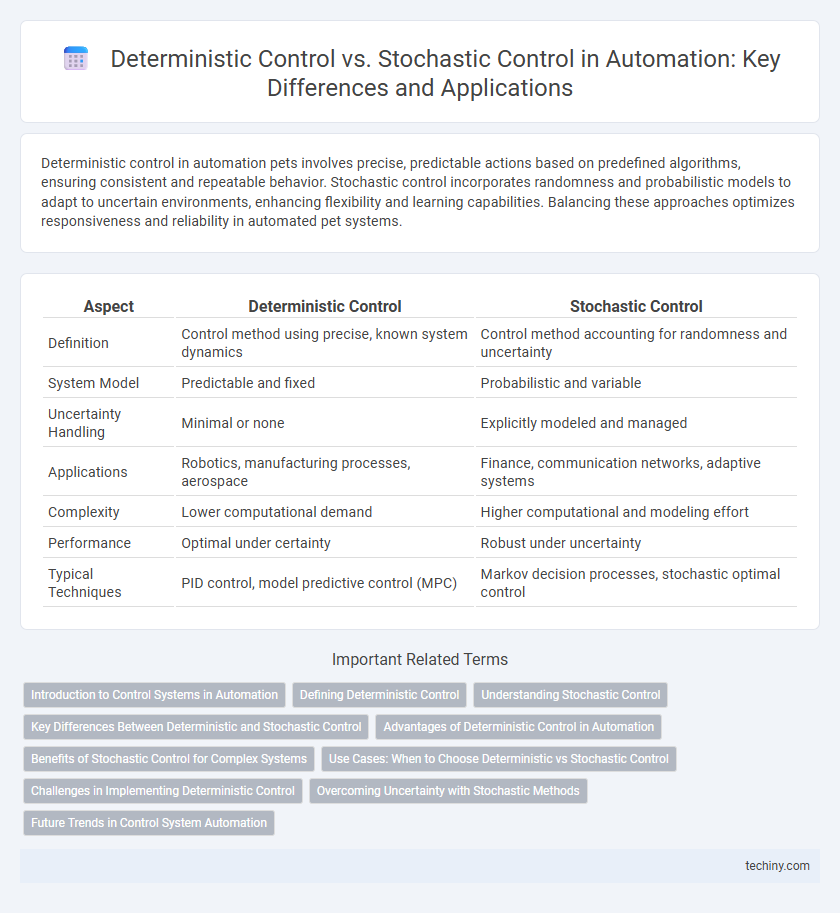Deterministic control in automation pets involves precise, predictable actions based on predefined algorithms, ensuring consistent and repeatable behavior. Stochastic control incorporates randomness and probabilistic models to adapt to uncertain environments, enhancing flexibility and learning capabilities. Balancing these approaches optimizes responsiveness and reliability in automated pet systems.
Table of Comparison
| Aspect | Deterministic Control | Stochastic Control |
|---|---|---|
| Definition | Control method using precise, known system dynamics | Control method accounting for randomness and uncertainty |
| System Model | Predictable and fixed | Probabilistic and variable |
| Uncertainty Handling | Minimal or none | Explicitly modeled and managed |
| Applications | Robotics, manufacturing processes, aerospace | Finance, communication networks, adaptive systems |
| Complexity | Lower computational demand | Higher computational and modeling effort |
| Performance | Optimal under certainty | Robust under uncertainty |
| Typical Techniques | PID control, model predictive control (MPC) | Markov decision processes, stochastic optimal control |
Introduction to Control Systems in Automation
Deterministic control systems operate under predefined models with predictable behavior, enabling precise automation in manufacturing and robotics. Stochastic control incorporates randomness and uncertainties, optimizing performance in dynamic environments like autonomous vehicles and adaptive process controls. Understanding both approaches is essential for designing robust automation systems that balance predictability with flexibility.
Defining Deterministic Control
Deterministic Control refers to a control strategy where system behavior is precisely predictable based on predefined models and inputs, with no randomness involved. It relies on exact system dynamics and known initial conditions to produce consistent and stable outcomes. This approach is essential in automation systems requiring high reliability and predictable performance, such as industrial robotics and process control.
Understanding Stochastic Control
Stochastic control involves managing systems affected by random variables and uncertainties, enabling decision-making under probabilistic conditions. Unlike deterministic control, which relies on precise models and predictable outcomes, stochastic control incorporates noise and disturbances to optimize performance over time. This approach is essential in automation applications such as robotics, finance, and adaptive systems where uncertainty is inherent.
Key Differences Between Deterministic and Stochastic Control
Deterministic control systems operate with predefined models where all variables and outcomes are known and predictable, ensuring precise and repeatable control actions. Stochastic control incorporates uncertainty and randomness, modeling systems with probabilistic elements to optimize performance despite unpredictable disturbances. Key differences include the predictability of system behavior in deterministic control versus the probabilistic decision-making required in stochastic control, affecting design complexity and application scope in automation processes.
Advantages of Deterministic Control in Automation
Deterministic control in automation offers precise predictability and consistency, ensuring system responses are accurately repeatable under predefined conditions. This control type enables real-time decision-making with minimal computational complexity, reducing latency and improving system reliability. Its clear-cut algorithms facilitate straightforward troubleshooting and maintenance, enhancing operational efficiency in automated processes.
Benefits of Stochastic Control for Complex Systems
Stochastic control offers significant benefits for complex systems by effectively managing uncertainty and dynamic variability often present in real-world environments. Unlike deterministic control, which relies on fixed models, stochastic control incorporates probabilistic models to optimize performance under unpredictable conditions. This approach enhances robustness, adaptability, and decision-making accuracy in fields such as robotics, finance, and autonomous systems.
Use Cases: When to Choose Deterministic vs Stochastic Control
Deterministic control excels in manufacturing processes, robotics, and systems with predictable environments where precise, repeatable outcomes are critical. Stochastic control suits applications involving uncertainty and variability, such as financial modeling, autonomous driving, and adaptive signal processing. Choosing between the two depends on the system's uncertainty level, real-time adaptability requirements, and the availability of accurate probabilistic models.
Challenges in Implementing Deterministic Control
Deterministic control faces challenges such as sensitivity to model inaccuracies and environmental disturbances, which can cause system performance degradation. The strict reliance on precise mathematical models limits adaptability in dynamic or uncertain environments. Implementing deterministic control often requires extensive system identification and tuning, increasing complexity and cost.
Overcoming Uncertainty with Stochastic Methods
Stochastic control methods address uncertainty in automated systems by incorporating probabilistic models that predict a range of possible outcomes, enhancing decision-making under unpredictable conditions. Unlike deterministic control, which operates on fixed inputs and outputs, stochastic control dynamically adapts to variability and noise in sensor data, improving robustness and reliability. This approach leverages techniques such as Markov decision processes and Monte Carlo simulations to optimize system performance despite inherent uncertainties.
Future Trends in Control System Automation
Deterministic control systems are expected to evolve with the integration of real-time data analytics and edge computing, enhancing precision in automated processes across industries. Stochastic control will leverage advancements in artificial intelligence and machine learning to improve decision-making under uncertainty, enabling adaptive automation in dynamic environments. Future trends indicate a hybrid approach combining deterministic algorithms with probabilistic models to optimize control system performance and resilience in complex automation scenarios.
Deterministic Control vs Stochastic Control Infographic

 techiny.com
techiny.com